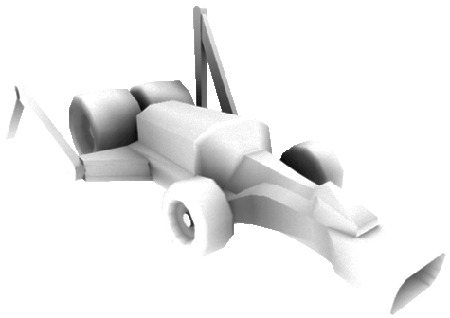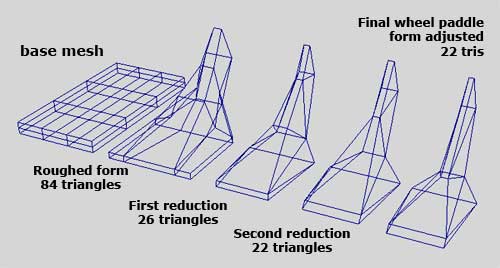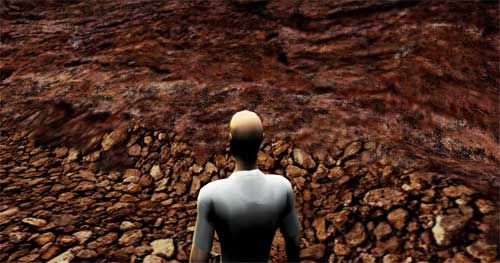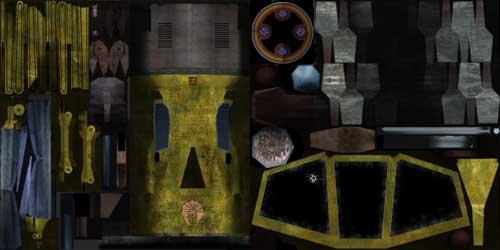Adrael's D'ni Mining Machine started as a sketch by Clat; this is the same one seen on the desk in the DRA "office".

I don't think he intended it to become a modeled game feature. But at that time I wanted to test a few techniques and building this device seemed like a perfect way to do it...I was not adamant that the finished model be used in-game.
For me, this partially began as a test to see how much I could get out of a single 1024X1024 texture, if UVs were very carefully plotted.
Modeling was easy; symmetry was maintained - except for the positions of the rear legs/pincers and the front scraper/scoopers, of course. The first question-mark came when it became apparent that the wheels, as designed, still looked very "chunky" even with eleven sides and over 260 tris each. In order to get this wheel design to look smooth in-game, it looked like we'd need almost twice as many facets per wheel, meaning a total of around 2000 tris for all four wheels: far more than I wanted to spend.


I knew I had to make the full-sized machine first, then try to eliminate as many faces as possible to create as low-impact a model-sized version as possible. I also decided that for two features transparency would be necessary: on the full-size machine the operator's cab would need transparency in its windows, and on the miniature version I wanted to eliminate many of the wheel faces by simulating the paddles with simple geometry and creating the "empty" space between by applying transparent texture. (I now know this could have been accomplished at least one other way...)
But transparent textures are expensive: they effectively double the megabyte size of any texture used by URU's rendering engine (even though you'd think the transparency data would take up only a third or less of the space required by RGB color data). So I decided to segregate the miner's cab UVs and the wheel UVs onto a separate, smaller 512X512-pixel texture. With this approach I was able to complete modeling while working on the UV sets. In the end, the entire full-size machine is less than 2800 triangles.
Texturing / UVsI spent at least a couple hours rearranging the UV sets within texture space, trying to maximize every bit of a 1024X1024 texture. Size allocation was not proportionate to the model pieces' sizes but rather to the level of inspection each part was likely to get in-game, and the amount of detail it had to carry.
|
|
Once the miner's cab had been modeled, along with the human-size seat inside, we were able to infer its overall size at over 150 feet long - from its front scrapers to extended rear claw. An extended space in Lyllus' Dragon Canyon area would have to be opened up to fit it!
A cul-de-sac in the original model had its walls cut, spread apart, then bridged by new mesh. Texture was applied to these new walls, then new edges were placed where needed in order to sculpt the recesses and outcroppings suggested by the texture itself. Lastly, a shadow map was generated to enhance the actual geometry of the mesh (rather than the original geometry of the sediment in the texture).
The floor area was an experiment to see whether large chunky rocks within a tiled texture could be isolated one by one using a piece of matte art. This stencil piece was digitally airbrushed around the entire perimeter of the quarry area, trying to make an erratic blend between the walls and the groundplane. I felt it worked to some extent, some places better than others, and with the addition of a lot more small 3D rocks in the area it might almost be plausible!

The miniature version's polygon count was very carefully reduced - from the original 2800 down to fewer than 1550 tris - through a lot of manual culling. The only real trick here was to replace the original wheels' "paddles" with a simple ten-sided wheel form, then apply a transparent-background .png texture to these wheels to suggest the full-sized paddle-feet.
Of course, new texture maps were made for this version, and a smaller 512X master was substituted for the full-sized version's 1024X texture...but another 512X texture was added for the marble base!

Total texture size (in-game DTX filesizes) for the full-size machine was 683KB for the non-alphaed 1024X1024 main texture, and 342KB for the 512X512 alphaed cab / wheel texture file, for a total of one 1MB (1024KB). The original test - to see what could be achieved by creating texture by prelayering in a graphics app like Gimp or Photoshop - worked pretty well, and I think is a good approach when you have a model composed of many small parts with different textures. However I wasn't completely happy with the overall texture on the main miner body - it doesn't have the crisp resolution I'd have preferred to see there. In retrospect it might have been better to have applied some much smaller tiled textures to it in layers. The single-texture prelayered approach seems better suited to objects composed of a number of small, differently-textured parts, where it can save time without loss of resolution.
Emor D'ni Lap, May 2011




